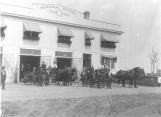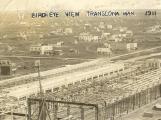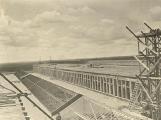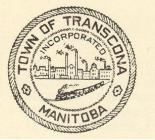1
At the turn of the 20th century, the railway was the most important method of moving goods and people across Canada. Major repair facilities were required to service all types of steam locomotives and railway cars carrying freight and passengers. In 1906, the Grand Trunk Pacific Railway surveyed a huge piece of flat, prairie land as the future location for their railway repair shops. Located seven miles east of Winnipeg, the site was chosen because of its close proximity to the booming City of Winnipeg and the abundant land that the site provided for future expansion. Between 1906 and 1907, the Dominion Government of Canada and the Grand Trunk Pacific Railway jointly purchased 800 acres of land for their railway shops.3
Construction of the railway shops began in June 1909. The prospect of steady employment attracted hundreds of workers to the site of the area was quickly covered with the tents of construction gangs and hurriedly built shacks. Early church services were held on railway property, at first in a tent, and for a time in a men's boarding house. In a matter of a few years, an area that had once been sparsely settled farmland was transformed into a booming industrial railway site.4
Advertisement taken from a pamphlet designed to attract people to the new townsite1910
Transcona, Manitoba, Canada

5
The construction of the Grand Trunk Pacific shops influenced the development of the future railway town and served as a catalyst in attracting real estate developers, merchants and businessmen to the area. As early as 1910, a new settlement known as Transcona was home to workers building the shops. The promise of economic prosperity centered around the future of the railway fuelled the optimistic growth of the settlement through 1911.7
In keeping with the railway origins of the town, it is claimed that the name "Transcona" was chosen from thousands of contest entries to commemorate the industrial beginnings of the settlement. "Trans" from the "National Transcontinental Railway" that, together with the Grand Trunk Pacific Railway, built the shops; and "cona" to honour "Lord Strathcona" who was involved with the construction of the Canadian Pacific Railway and drove the "last spike" in the CPR in 1885.9
Portion of a real estate brochure, used to entice buyers to purchase lots in Transcona1911
Transcona, Manitoba, Canada

11
By the time that the Transcona Board of Trade was established in 1911, it was reported that five hundred of the eight hundred residents living in Transcona were employed in the construction of the Transcona Railway Shops. The town continued to grow and attracted more merchants, businesses and railway workers.12
Volunteer fire brigade and horses in front of the Transcona Municipal Offices and Fire Hall1915
Transcona, Manitoba, Canada

14
Notre Dame de l'Assomption (Our Lady of the Assumption Church)1913
609 Leola Street, Transcona, Manitoba, Canada





